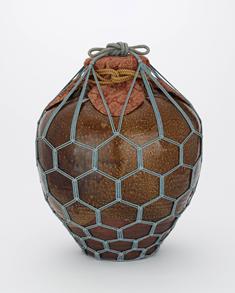
Tea-leaf storage jar, named Chigusa, China, Southern Song or Yuan dynasty, 13th14th century. Stoneware with iron glaze, height 41.6 cm. Freer Gallery of Art Purchase.
Freer Gallery of Art and Arthur M. Sackler Gallery
The Smithsonian Museums of Asian Art
The Story of Chigusa: A Japanese Tea Jar's 700-Year History
Saturday 27 August, 9, 10:30 PM Eastern Daylight Time (EDT)
Sunday 28 August, 10, 11:30 AM Japan Time (JST)
To register, click here. The Smithsonian's Freer Gallery of Art and Arthur M. Sackler Gallery invite you to participate in a free online workshop, rescheduled from its original March date.
What can a single jar tell us about how objects acquired history and meaning within Japanese tea culture? When the Freer Gallery of Art recently acquired a tea-leaf storage jar named Chigusa, the museum became yet another participant in a seven-century-long story, in which a Chinese jar came to Japan and was transformed into a famous and much-admired container for tea leaves, even acquiring a personal name. Tea masters' diaries and connoisseurs' handbooks described and ranked the jar; successive owners endowed it with Chinese brocades, silk cords, inscriptions, documents, and multiple boxes. Chigusa has been described as a "time capsule"-an embodiment of the fascinating and complex process by which tea-related objects accrued meaning and value. Only a few hundred such jars with comparable pedigrees survive in Japan, and few are as extensively documented.
Four scholars gathered in Washington recently-in Chigusa's inspiring presence-to consider aspects of the jar's story. In this free online workshop, they will share their thoughts and discoveries, and then engage in discussion with participants.
PRESENTERS
Louise Allison Cort, Curator for Ceramics, Smithsonian's Freer | Sackler
How a Chinese jar became Chigusa; why Chigusa came to the Freer
Takeuchi Jun'ichi, Director, Hosokawa Collection-Eisei Bunko
How did tea men look at Chigusa 400 years ago?
Andrew Watsky, Professor, Department of Art and Architecture, Princeton University
Chigusa's name(s)
Oka Yoshiko, Professor, Faculty of Cultural and Historical Studies, Otemae University
Who owned Chigusa?
MORE INFORMATION
A press release about Chigusa can be found in the Freer | Sackler press room.
SPONSORS
"The Story of Chigusa" online workshop is generously funded by Toshiba International Foundation.
Support for Mr. Takeuchi's participation provided by the Japan Society of Boston and Continental Airlines.
Jay and Toshiko Tompkins have supported a forthcoming publication on Chigusa.
Produced by LearningTimes.
Click here for registration and participation procedures.